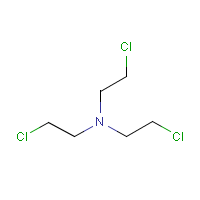Nitrogen mustard (HN-3)
Agent Name
Nitrogen mustard (HN-3)
Alternative Name
Tris(2-chloroethyl)amine
CAS Number
555-77-1
Formula
C6-H12-Cl3-N
Major Category
Toxic Gases & Vapors

Synonyms
Tris(2-chloroethyl)amine; 2,2',2''-Trichlorotriethylamine; 2-Chloro-N,N-bis(2-chloroethyl)ethanamine; A 8729; Agent HN3; Ethanamine, 2-chloro-N,N-bis(2-chloroethyl)-; HN-3; HN3; Sinalost base; TL 145; TS 160; Tri-(2-chloroethyl)amine; Trichlormethinum [INN-Latin]; Triclormetina [INN-Spanish]; Triethylamine, 2,2',2"-trichloro-; Trimitan base; Trimustine; Tris(beta-chloroethyl)amine; UN 2810; [ChemIDplus]
Category
Chemical Weapons
Description
Colorless to pale yellow, oily liquid with a faint butter almond odor; [ATSDR-MMG]
Sources/Uses
Used in medicine as an antineoplastic drug; A vesicant that has not been used as a chemical weapon; [HSDB]
Comments
"Nitrogen mustards are vesicants causing skin, eye, and respiratory tract injury. Although these agents cause cellular changes within several minutes of contact, the onset of pain and other clinical effects is delayed for hours. Nitrogen mustards are alkylating agents that may cause bone marrow suppression and neurologic toxicity. . . . Nitrogen mustards may decrease fertility." [ATSDR MMG]
Reference Link #1
Biomedical References
Exposure Assessment
TIH
Yes
Vapor Pressure
0.011 mm Hg
Explanatory Notes
LCt50 = 1,500 mg-min/m³; [ATSDR-MMG] VP from ChemIDplus;
Adverse Effects
Anemia
Aplastic anemia
Toxic Pneumonitis
Yes
Neurotoxin
Other CNS neurotoxin
Reproductive Toxin
Yes
Dermatotoxin
Skin burns
IARC Carcinogen
Probable (2a)
NTP Carcinogen
Anticipated human carcinogen
Diseases, Processes, and Activities Linked to This Agent
Diseases
Occupational diseases associated with exposure to this agent: